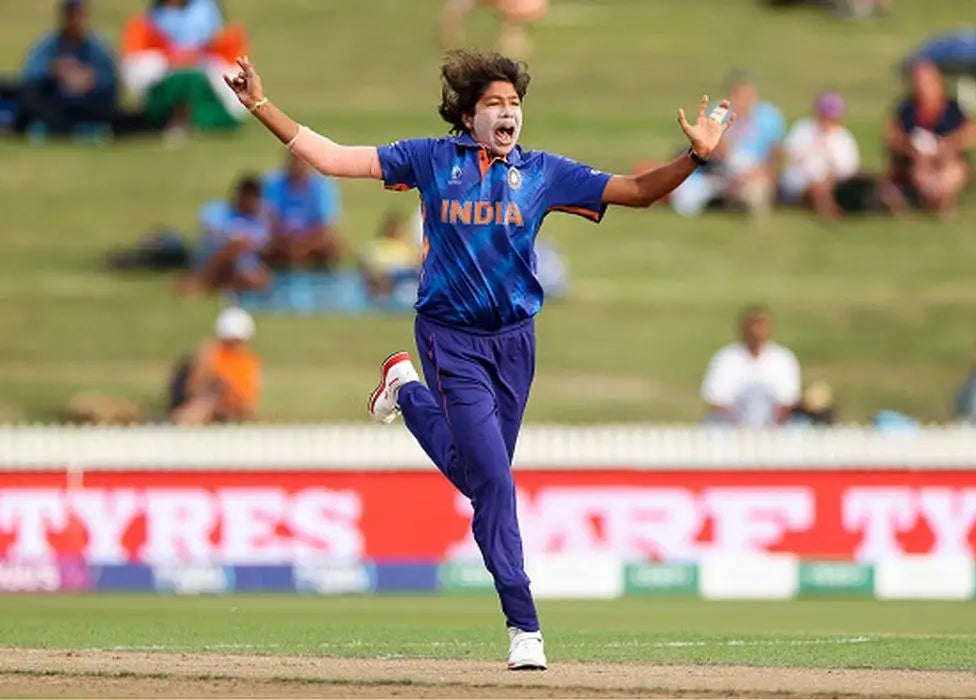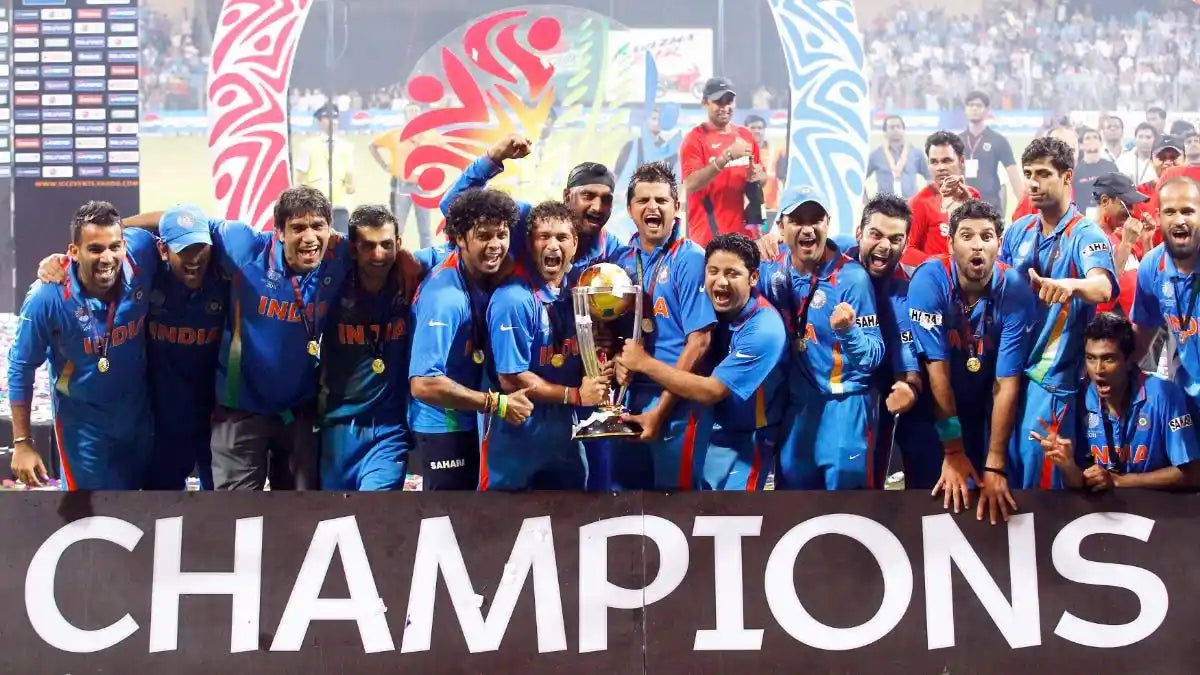"You don't play for the crowd, you play for the country."
This is what MS Dhoni says about playing for the Indian National Cricket Team. It is not just a job for every player that wears the blue and represents our country, for them it is all about going out there and giving it all for our nation. It's a commitment to give your heart and soul on the field, to carry the hopes and dreams of a billion of fans with every stroke of the bat and every delivery bowled. This dream of representing India is one that every child dreams about, but only a select few can work tirelessly to achieve. It's a journey filled with sacrifices, dedication, and unwavering passion, all in the name of serving the nation through the sport we love.

Credit: Hindustan Times
So, in this article by ZAP, let’s read about the Indian Cricket Team, which every youngster wished to play for.
The Origins of Indian Cricket:

Credit: Wikimedia Images
The history of cricket in India is due to the British Colonial Era. The sport originated in England and was brought and introduced to the subcontinent by the British colonizers. The sport grew in popularity and soon was adopted by the masses. The first recorded match in India took place in 1721. Many club came up that competed in local matches and usually against English and European and some players even played for the England Cricket Team. India joined the International Cricket Council in 1926 and made their Test debut in England in 1932 under the captainship of CK Nayudu, who was regarded as the best Indian batsman at the time.
History of Indian Cricket Team: A Timeline
The Early Years:

Credit: Wikimedia Images
Despite making improvement throughout the 1930s and 1940s, the Indian side failed to win a match abroad during this time. Due to World War II, India did not participate in any men's Test matches in the early 1940s. The squad's first international series as an independent nation took place in England in late 1947 against Don Bradman's Australian team. In 1948, India played their first home Test series against the West Indies rather than England. West Indies won the 5 match Test Series by 1-0. In their 24th Test match against, India recorded their first ever victory against England in Madras in 1952. Later in the same year, they won their first ever Test series, which was against Pakistan.
India under Kapil Dev - The 1983 World Cup:

Credit: Sportskeeda
Indian pitches, due to the nature of the soil and the moisture content has a tendency to support spin. This allowed India’s spin bowling maestros, Bishan Singh Bedi, E. A. S. Prasanna, B. S. Chandrasekhar and Srinivasaraghavan Venkataraghavan, in the 1970s to dominate the opposition batting lineups. It was this period, when we saw the rise of some of the greatest Indian players ever, Kapil Dev, Sunil Gavaskar, Mohinder Amarnath, Roger Binny and Ravi Shastri. Everything changed in the year 1983. The team that was looked upon as a weakling and an easy to beat time conquered the world at the biggest stage, winning the ICC World Cup in 1983. We had one of the worst starts in the tournament and then went on to win the glorious trophy. There were some stellar performances in the tournament by many player, like the Semi Final and Final all-round performance by Mohinder Amarnath, but one that always remains in the minds of people is Kapil Dev’s 175 off 138 deliveries against Zimbabwe. It was a blistering innings which still remains one of the greatest ODI knocks ever. He leadership style too was very motivating. He kept the team motivated and always made them believe that that 1983 World Cup Team was built to achieve big and that’s what they did. The landscape of the sport in the country changed forever after that win against West Indies. More and more children started aspiring to play for the country at the biggest stages.
The Turbulent Rise of Legends:

Credit: Wisden
The future of Indian Cricket looked bright as the some of the greatest legends made their way to the national teams. A 15 year boy, name Sachin Tendulkar made his debut for India in 1989, and who knew this boy would go onto change the future of the team and be called the God of Cricket 24 years later. Another player Anil Kumble, who would go onto become the leading wicket taker for India would get called up for national team duties in 1990s. Two other players, Sourav Ganguly and Rahul Dravid made their ways up the ladder and made their debuts for the Indian Team in the 90s. Though the team did not see much success on the international stages during this period under Mohammad Azharuddin’s captaincy, but the backbone was strong and set to do big at the international stage.
Sourav Ganguly (Dada’s) Era:

Credit: Hindustan Times
Sourav Ganguly took charge of the Indian Cricket Team in the late 90s and this was the period which many believe was the defining moment for India. The team that comprised of players like Sachin Tendulkar, Rahul Dravid, Ajit Agarkar, Zaheer Khan, Venkatesh Prasad, a young Harbhajan Singh and Yuvraj Singh played for the team with heart. Sourav Ganguly with the then India coach John Wright, led the team with courage and aggressiveness and that changed the future of the team. The team that was too timid to show hunger now had a fire to win and conquer. India shared the 2002 ICC Champions Trophy with Sri Lanka, in a match which was washed away by rain, and then in 2003 reached the Finals of the ODI World Cup. One of the most remembered moments of Dada’s era was the Natwest Series Final at the Lord’s Ground. India won the match from a crunch situation and Dada replied by taking his shirt off and swinging it around the balcony.
MS Dhoni’s Magical Touch:
MS Dhoni, the captain cool, who made his debut for the Indian Cricket Team in 2004, brought a unique blend of calmness and determination to the squad. His leadership style and pin point decision-making took India to new heights on the world stage.
ICC 2007 T20 World Cup:

Credit: The Times of India
Under the leadership of a young M.S. Dhoni, India went on an incredible journey at the 2007 ICC T20 World Cup. In the final match, we defeated our Arch Rivals Pakistan to win the inaugural tournament, against all odds. The team, which didn't have the main players like Sachin Tendulkar, Rahul Dravid and VVS Laxman and was carried by young players, surprised everyone by displaying remarkable talent, poise, and coordination.
ICC ODI World Cup 2011:

Credit: India Today
Then in the 2011 World Cup, we even won the ODI World Cup, a dream that every Indian wished for 28 years. Under brilliance of players like Yuvraj Singh, Gautam Gambhir, Tendulkar and a collective bowling efforts by our bowling arsenal including Zaheer Khan, Harbhajan Singh, Munaf Patel, Irfan Pathan, we dominated the tournament beating Kumar Sangakkara led Sri Lanka in the final. And who can forget the six that Dhoni hit, one of the most iconic moments in our sporting history.
2013 ICC Champions Trophy:

Credit: Hindustan Times
Then Dhoni became the only captain ever to win all three ICC Trophies after winning the 2013 Champions Trophy. Dhoni’s period can be defined by a calmness and clinicality. He shaped the career of Rohit Sharma by starting him as the opener and made spin bowling through Ravichandran Ashwin and Ravindra Jadeja his main weapon.
Fearless Virat Kohli:

Credit: The Telegraph
Virat Kohli, one of the best batsman of modern times took charge of the team after Dhoni left his captaincy in 2016 and since then it has been ups and downs for the Indian Cricket Team. Though we have failed to make any remarkable progress in the ICC events, but our bilateral form has been unrivalled with. The two Test series in Australia and the Lord’s Test vs England, can sum up Kohli’s period. A period defined by mentality and fearlessness.
The Current Era - Under Rohit Sharma:

Credit: The National
Right now, the captain of the team in Rohit Sharma, who is also one of the best players in the Team. His journey started after Kohli had a fallout with the team management and decided to step down from his post as the skipper. Rohit Sharma definitely has the pedigree to lead a top side as he has done with the Mumbai Indians in the IPL. Let’s see if he can instill his winning mentality and philosophy and make his mark on the team. While he faces the challenge of building a new team philosophy, all eyes are on the upcoming 2023 ICC ODI World Cup, where India aims to reclaim the trophy.
The Role of BCCI:
In all of the success that India has seen in the sport at the international stage, one entity has played a huge role throughout. The BCCI stands for the Board of Control for Cricket in India does everything, from the ground based development for youngster to organise some of the biggest tournaments like the IPL which has become one of the biggest sources of finding talented players that can play at the highest level for the team. Apart from this, the BCCI also organizes the domestic tournaments like the Ranji Trohpy, the Duleep Trophy, the Syed Mushtaq Ali trophy and many more. They also put all their efforts in the development of women’s cricket and the Indian Women’s Team.

Credit: The Times of India
The President of the BCCI, Roger Binny, the 1983 World Cup winning legend, is in charge of the hierarchy. He is assisted by a group of office holders that jointly supervise the board's activities, including the Secretary, Jay Shah, the Treasurer, Ashish Shelar, and several other members. The BCCI also has a General Body comprising various state associations, each with its own President and office bearers, forming an essential part of the decision-making process. Additional committees and subcommittees, such as the Cricket Advisory Committee (CAC) for player selection and the IPL Governing Council for better functioning of the world's largest T20 tournament.
Read More: Asian Cricket Council | Cricket Australia
The Tournaments:
Indian Premier League:

Credit: Hindustan Times
The IPL is one of the biggest cricket competition that has transformed the game via its distinctive fusion of talent, entertainment, and glitz. It is a T20 competition filled with exciting last-ball victories and fierce on-field rivalries. The IPL's steady expansion has contributed to the global expansion of T20 format, making it perhaps the best league in the world.
Ranji Trophy:

Credit: ESPN Cricinfo
The Ranji Trophy is a domestic first-class championship played in India involving numerous teams representing regional and state cricket bodies. It was established in 1934 by the BCCI, and since then, it has been organised yearly on different Indian fields and stadiums.
There are now 38 teams in the league, with at least one squad from each of the 28 Indian states and four of the eight union territories. Originally known as "The Cricket Championship of India," it was renamed in 1935 to honour Ranjitsinhji, the first Indian to play in an international match, who represented England from 1896 to 1902.
Syed Mushtaq Ali Trophy:

Credit: The Times of India
The BCCI hosts the Syed Mushtaq Ali Trophy, a domestic T20 competition in India that features teams from the Ranji Trophy. It bears Syed Mushtaq Ali's name, a former test cricketer for India. The tournament's most successful team, Tamil Nadu, has won it three times and Mumbai is the current winner.
Duleep Trophy:

Credit: Sportskeeda
The Duleep Trophy is an Indian First-Class competition. It bears the name of Kumar Shri Duleepsinghji, the Indian playerwho represented England before the Indian Cricket Team was formally formed. The BCCI decided to establish this domestic league in his memory after his death in 1959. Initially, teams that represented the nation's many geographic regions competed in it., but now they have been chosen by the BCCI since the 2016–2017 edition.
Indian Men’s Cricket Team Players:
The Indian Men’s Cricket team has been one of the best national teams of all time and has given birth to some of the biggest legends in the sport.
Sachin Tendulkar:

Credit: The Times of India
Sachin Tendulkar is one of the best players that we have ever produced and can also be considered the undoubted GOAT of of the sport. He holds records that players can only dream of getting to. He is the player with the most runs and the most centuries.
Some of his records include most runs in all formats, most centuries in history and many other which have no count.
Virat Kohli:

Credit: Mint
Behind him is King, Virat Kohli, one of the best modern day players. His numbers are just astonishing and he is an inspiration to all plyers to work towards their fitness and has redefined the sport in this aspect.
MS Dhoni:

Credit: myKhel
MS Dhoni will always remain the best wicket keeper ever and can also be considered the greatest captain in the history of the sport. While no one can be as good behind the stumps as Dhoni, here are wicket keeping tips and techniques that will help you become a legends behind the stumps with the keeping gloves and pads.
Yuvraj Singh, Virendra Sehwag, Gautam Gambhir, Yuvraj Singh, Suresh Raina, VVS Laxman, Irfan Pathan, Zaheer Khan, Rohit Sharma are some other players who have had a huge impact on the sport with their class.
Indian Women’s Cricket Team Players:
India has made significant progress towards building an infrastructure that gives women the same opportunities as men to play the beautiful game.
Mithali Raj:

Credit: Olympics.com
Mithali Raj is one of the greatest female cricketers to ever grace the sport. Her brilliance with the bat helped us win innumerable matches. She has scored over 6,800 runs in ODIs, leading the Indian Women's Cricket Team in runs scored, displaying unmatched consistency and scoring runs when needed most. Her leadership accomplishments and the accolades she has received, such as the Padma Shri and Arjuna Award, confirm her place among the most recognisable figures in women's cricket.
Jhulan Goswami:

Credit: BBC
Jhulan Goswami, once again is one of the best we have ever produced. She was a right-arm medium quick bowler and is regarded as one of the greatest bowlers to have ever bowled a delivery. She even was one of the fastest female bowlers in history. Before retiring in 2022, she played 204 ODI games and picked up 255 wickets and holds the record for most wickets in women's ODI cricket.
Numerous athletes have become stars both on and off the pitch. Shafali Verma, who is renowned for her explosive batting, will be India's next big thing. Harmanpreet Kaur is a brutal striker of the ball and makes us think of Virender Sehwag, his idol. Smriti Mandhana has the potential to become the greatest batswoman in Indian history. Harleen Deol, Jemimah Rodrigues, and Deepti Sharma are three outstanding young players who have the potential to guide their team into the future.
Conclusion:
The future of Indian Cricket Team, both for men and women looks bright with the upcoming young superstars. The upcoming talents like Yashasvi Jaiswal, Shubhman Gill, Rishabh Pant, Arshdeep Singh and many more, the future looks good. Pant looks exactly like the hard hitting replacement of Dhoni, while Gill is the next Prince after Kohli and Yashasvi Jaiswal the role that Shikhar Dhawan played, our batting lineup looks set for years. As BCCI continues to work from behind the curtains to bring in more and more talent and make our national teams a sporting dynasty on the world stage, we will continue to give our best support and always BLEED BLUE!



Share:
Cricket In England: The History, Players, and the ECB
Common Injuries in Cricket & Prevention and Treatment